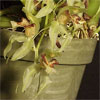|
|
|
|
|
| |
Flasks of
Coelogyne assamica '#3' × 'Stradivarius' |
|
| |
|
|
| |
|
|
Click to Enlarge

Pod Parent Flowers |
Click to Enlarge

Pollen Parent Flowers |
|
|
|
| |
For additional origin/habitat information supplied courtesy of
Charles and Margaret Baker, see further below, near the bottom of this page.
|
Temperatures we attempt to use in the lab & greenhouse:
| For Species: |
|
Spring, Summer, Autumn: days average 84°F, nights 73°F; best fit is Warm 90-70°F
(Source:
Baker's Web OSC) |
| For Species: |
|
Winter: days average 71°F, nights 51°F; best fit is Cool 70-52°F
(Source:
Baker's Web OSC) |
|
About the name...
| Etymology of |
assamica |
|
Means "from Assam" (Indian state)
(Source:
Mayr & Schmucker 1998) |
| Etymology of |
Coelogyne |
|
From latinized Greek "koilos" hollow, cavity; "gyne" woman, womb, stigma. The column is frontally hollow.
(Source:
Mayr & Schmucker 1998) |
| Pronunciation of |
Coelogyne |
|
see-LAW-ji-nee
(Source:
Hawkes 1978) |
|
If you would like to direct someone to this web page, please copy and paste this URL into your email:
http://troymeyers.com/d?016500
| Flask Information |
| Availability: |
There were problems with this item and we weren't able to make any viable flasks. |
| You should: |
Consider placing a "Notify Retries" Request, and if an identical pollination (the same parents) is done again, we'll let you know. |
|
You might also want to:
|
View the seed assay for this item.
View items of the same species.
View items of the same genus.
|
|
|
| |
The origin/habitat information below is supplied courtesy of Charles and Margaret Baker
The following information is based on the name of the plant provided by the donor, and assumes that the name is correct. If the plant has been misidentified, then the following information may not be correct.
This text is copyrighted by the Bakers and may not be reproduced without permission.
ORIGIN/HABITAT: Northeast India, Bhutan, Myanmar (Burma), China, Thailand,
Laos, and Vietnam. The type specimen was collected in Assam, a region in
northeast India. In Bhutan, plants grow in riverine forest at 2300 ft.
(700 m). In Vietnam, plants have been found near Dalat, Lac Durong, and
Langbian; and plants have been collected on the Bolovens Plateau in Laos,
but details of habitat elevation were not given for these locations.
More about this information and the Bakers...
|
|
|
| |
|
|
|